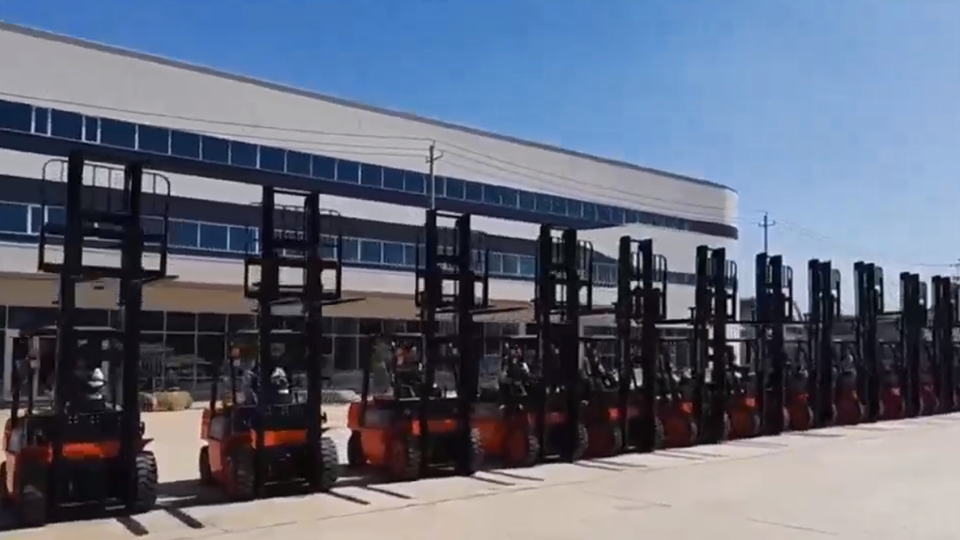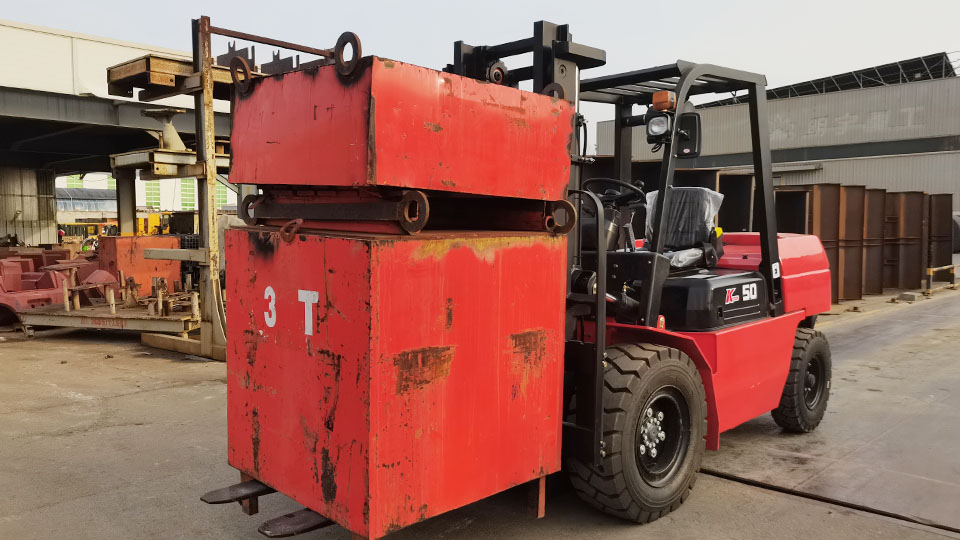
Introduction to Powered Industrial Truck (PIT) Operation
The Powered Industrial Truck, commonly known as the forklift, is a highly engineered, counterbalanced machine essential for material handling in warehouses, distribution centers, and industrial facilities. Unlike standard automobiles, a forklift is designed around a principle of static and dynamic stability, relying on a counterweight system and rear-wheel steering.
Successful operation is not merely a task of driving but a disciplined application of technical knowledge—encompassing pre-shift diagnostics, load stability physics, and adherence to strict operational protocols. This article provides a comprehensive technical guide to the operational workflow of a counterbalance forklift, emphasizing the critical safety and mechanical principles necessary for professional use.
1. Pre-Shift Inspection and Diagnostics
Federal safety regulations mandate that all PITs be inspected before the start of each work shift, or if used continuously, at the start of each new shift. This is a critical diagnostic procedure designed to identify and remediate mechanical or structural defects that could compromise the machine's stability and operational integrity.

1.1. Visual Inspection (Engine Off)
The operator must perform a thorough walk-around visual check, often documented on a standardized checklist.
|
Component Group |
Technical Check Points |
Acceptable Criteria |
|
Mast & Hydraulics |
Forks, Carriage, Load Backrest, Chains, Hoses, Cylinders |
No cracks, bends, or excessive wear on forks (especially the heel). Chain tension correct and lubricated. No hydraulic fluid leaks or frayed hoses. Load backrest extension securely fastened. |
|
Tires & Wheels |
Tire condition (Pneumatic/Solid), Lug Nuts, Pressure |
No chunking, excessive wear, or large cuts. Lug nuts present and tight. Pneumatic tires must meet specified pressure (refer to manufacturer's decal). |
|
Engine Compartment (IC Trucks) |
Fluid Levels, Battery, Belts |
Engine oil, hydraulic fluid, brake fluid, and coolant at manufacturer-recommended levels. No visible leaks (drips or puddles). Belts (alternator, power steering, etc.) checked for tension and wear. |
|
Propane System (LPG Trucks) |
Tank Condition, Hose, Relief Valve |
Tank mounted securely (proper restraint brackets). Tank not dented or damaged. Hose free of kinks, frays, or leaks (check for odor). Pressure relief valve oriented correctly (upward). |
|
Safety & Structure |
Overhead Guard, Operator Manual, Decals, Seatbelt |
Overhead guard free of broken welds or damage. Manufacturer’s capacity data plate and safety decals present and legible. Seatbelt/restraint device latches securely and is free of cuts/frays. |
1.2. Operational Check (Engine Running)
After the visual inspection is cleared, the engine is started to test dynamic systems.
Gauges and Controls: Confirm all dashboard gauges (e.g., oil pressure, temperature) are within normal operating ranges.
Warning Devices: Test the horn, headlights, brake lights, and the backup alarm (by engaging reverse).
Steering: Test for excessive "free play" (slack) in the steering wheel. Steering should be responsive and smooth.
Brakes:
Service Brake (Foot Pedal): Test at a slow speed; the truck must stop smoothly and promptly without pulling to one side.
Parking Brake: Test by applying the brake and gently attempting to accelerate forward; the brake must hold the truck stationary.
Hydraulics: Test the full range of motion for the lift, lower, and tilt functions (forward and backward). Movement must be smooth and hold its position without drifting.
Critical Protocol: Any defect or malfunction noted during the inspection requires immediate removal of the PIT from service. The issue must be reported and repaired by qualified maintenance personnel before operation is permitted.
2. Stability Dynamics: The Stability Triangle
The safe operation of a counterbalance forklift is predicated on the fundamental principle of the Stability Triangle and the management of the Combined Center of Gravity (CCG).
2.1. Defining the Stability Triangle
The stability triangle is an imaginary geometric area that forms the boundaries of the forklift's stability footprint. In a standard four-wheel counterbalance truck, this triangle is defined by three points of load support:
The two contact points of the front drive wheels.
The center pivot point of the rear steer axle.
For the forklift to remain stable, the vertical projection of the CCG of the truck and its load must remain within the boundaries of this triangle.
2.2. Center of Gravity (CG) Management
Unloaded Forklift: The CG is low and rearward, near the counterweight, ensuring high stability.
Loaded Forklift (CCG): When a load is lifted, the combined CG shifts forward and upward, moving closer to the forward edge of the stability triangle (the front axle).
Longitudinal Stability: Governs forward and backward tipping. The CCG must not shift too far forward or it risks a forward tip-over.
Lateral Stability: Governs sideways tipping. This is most affected by turning, operating on inclines, and uneven floor surfaces. A sudden turn can cause lateral forces to push the CCG outside the side boundaries of the triangle.
The Operator's Objective: To keep the CCG as low and as far back (toward the counterweight) as possible at all times, especially while transporting a load.
3. Load Handling and Manipulation Procedure
Load manipulation is a controlled, deliberate process that minimizes dynamic forces and respects the truck's rated capacity.

3.1. Approaching and Engaging the Load
Data Plate Check: Before attempting any lift, the operator must verify the load weight does not exceed the truck’s rated capacity, which is specified on the data plate for a given Load Center (typically 24 inches). Overloading immediately shifts the CCG out of the stable range.
Positioning: Approach the load straight-on and slowly, ensuring the forks are spaced correctly and centered laterally under the pallet or load.
Fork Insertion: Level the forks horizontally (mast vertical) and insert them fully beneath the load. The load should rest firmly against the load backrest extension. Rule of Thumb: Forks must be under at least two-thirds of the load's length.
Lifting: Lift the load only high enough to clear the stack or racking (approximately 4 inches).
3.2. Securing and Transporting the Load
Mast Tilt: Once the load is clear of the stack, immediately tilt the mast fully backward to secure the load against the carriage and pull the CCG back toward the center of the stability triangle.
Travel Height: Lower the load to the lowest safe transport position, generally 4 to 6 inches above the floor surface. This is paramount for maintaining a low CCG and maximum stability during movement.
Visibility: If the load obstructs the forward view (e.g., high-stacked product), the operator must travel in reverse, ensuring clear visibility in the direction of travel.
3.3. Stacking and Depositing the Load
Approach: Approach the rack or stack slowly, squarely, and stop approximately 12 inches away.
Elevation: Carefully lift the load to the required deposit height, constantly checking for overhead obstructions (pipes, lights, rack beams).
Positioning: Once at the target height, slowly and smoothly move forward to position the load.
Mast Tilt (Forward): Level the mast vertically before placing the load. Only tilt the mast cautiously forward to stabilize the load onto the stack or rack, then immediately neutralize the tilt control. Critical Caution: Never tilt a load forward when the forks are elevated above the travel height, as this rapidly shifts the CCG outside the stability triangle, risking a forward tip.
Extraction: Slowly back away, ensuring the forks clear the stack without snagging. Once clear, lower the forks back to the safe transport height.
4. Maneuvering and Traffic Protocols
Forklifts utilize rear-wheel steering, which creates a pronounced rear-end swing during turns. Operators must compensate for this mechanical characteristic to prevent collisions.
4.1. General Travel Rules
Speed Control: Operate at a speed that allows the truck to be stopped safely and quickly under all prevailing conditions. Avoid sudden stops, starts, or rapid steering changes, which introduce dynamic forces that compromise the CCG.
Aisle and Intersection Protocol: Sound the horn at all intersections, blind corners, entrances, and exits to alert pedestrians and other vehicles.
Clearance: Always check for both overhead and side clearance before moving, lifting, or turning. Maintain a safe following distance of approximately three truck lengths from other moving PITs.
4.2. Operating on Ramps and Grades
Operating on inclines demands a strict directional protocol to maintain longitudinal stability:
Loaded Travel: When traveling with a load, the heavy end must always face uphill to keep the CCG toward the counterweight. This means driving forward up the ramp and reverse down the ramp.
Unloaded Travel: When traveling without a load, the heavier end (the counterweight) must face uphill. This means driving reverse up the ramp and forward down the ramp.
Turning: Never attempt to turn or change direction while on an incline, as this drastically compromises lateral stability and risks a side tip-over.
5. Shutdown and Securing Procedures
Proper shutdown is the final safety-critical step in operation, preventing unintended movement and unauthorized use.
Lower Forks: Fully lower the forks/attachment to the floor surface.
Controls: Place all operating controls (directional lever) in the neutral position.
Parking Brake: Engage the parking brake securely.
Power: Turn the ignition key/power switch to the "Off" position.
Secure: Remove the key (or disconnect the battery plug on electric trucks) to prevent unauthorized operation.
Chocking: If the truck is parked on any grade, the wheels must be chocked.
Conclusion
The safe and efficient operation of a forklift is a skilled profession demanding technical proficiency in the machine's mechanics and stability principles. By rigorously adhering to the pre-shift inspection protocol, respecting the physics of the Stability Triangle, and executing load handling maneuvers with deliberate precision, the operator can mitigate the inherent risks of powered industrial truck operation, ensuring a secure and productive material flow. Consistent training and adherence to manufacturer and regulatory standards (such as OSHA) are the foundation of professional forklift operation.
Name: selena
Mobile:+86-13176910558
Tel:+86-0535-2090977
Whatsapp:8613181602336
Email:vip@mingyuforklift.com
Add:Xiaqiu Town, Laizhou, Yantai City, Shandong Province, China